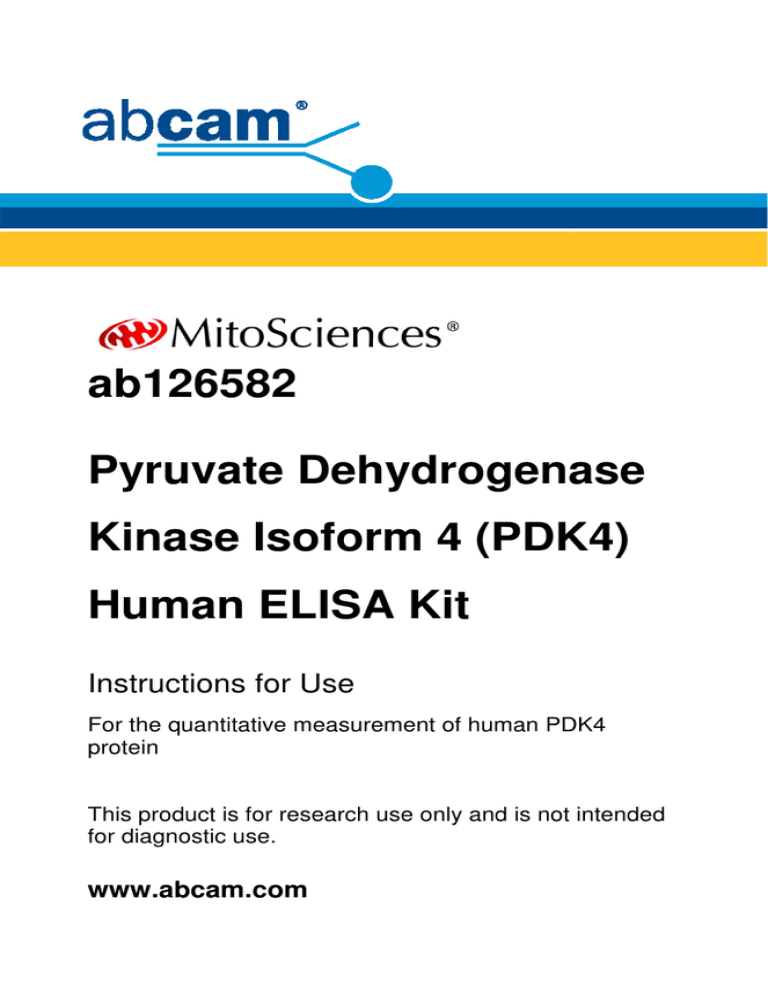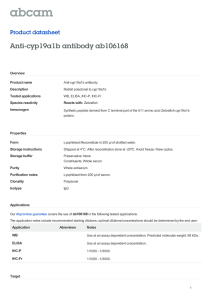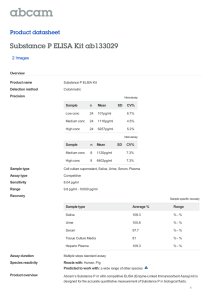
ab126582
Pyruvate Dehydrogenase
Kinase Isoform
soform 4 (PDK4)
Human ELISA Kit
Instructions for Use
For the quantitative measurement of human PDK4
protein
This product is for research use only and is not intended
for diagnostic use.
www.abcam.com
ab126582 Human PDK4 ELISA Kit
1
ab126582 Human PDK4 ELISA Kit
Table of Contents
1.
Introduction
3
2.
Assay Summary
5
3.
Kit Contents
6
4.
Storage and Handling
6
5.
Additional Materials Required
7
6.
Preparation of Reagents
8
7.
Sample Preparation
10
8.
Assay Procedure
12
9.
Data Analysis
15
10. Specificity
19
11. Troubleshooting
22
2
ab126582 Human PDK4 ELISA Kit
1. Introduction
Principle: ab126582 Pyruvate Dehydrogenase Kinase isoform 4
(PDK4) Human ELISA (Enzyme-Linked Immunosorbent Assay) kit is
an in vitro enzyme-linked immunosorbent assay for the accurate
quantitative measurement of PDK4 protein in human tissue lysates.
The assay employs an antibody specific to PDK4 protein coated onto
well plate strips. Standards and samples are pipetted into the wells
and PDK4 present in the sample is bound to the wells by the
immobilized antibody. The wells are washed and a primary antiPDK4 detector antibody is added.
After washing away unbound
detector antibody, HRP-conjugated secondary antibody (HRP Label)
specific for the primary detector antibody is pipetted into the wells.
The wells are again washed, a TMB substrate solution is added to
the wells and color develops in proportion to the amount of bound
PDK4. The developing blue color is measured at 600 nm. Optionally
the reaction can be stopped by adding hydrochloric acid which
changes the color from blue to yellow and the intensity can be
measured at 450 nm.
3
ab126582 Human PDK4 ELISA Kit
Background: The oxidation of carbohydrates in mammals is
regulated by the pyruvate dehydrogenase (PDH) complex, which is
covalently regulated by four PDH kinases (PDK1-4) and two PDH
phosphatases
(PDP1-2)
through
a
phosphorylation-
dephosphorylation cycle. PDK4 inhibits the mitochondrial pyruvate
dehydrogenase complex by phosphorylation of the E1 alpha subunit,
thus contributing to the regulation of glucose metabolism. PDK4
exists ubiquitous with highest levels of expression in heart and
skeletal muscle. PDK4 transcription and PDK4 mRNA are markedly
increased in human skeletal muscle during prolonged exercise and
after both short-term high-intensity and prolonged low-intensity
exercise. The exercise-induced transcriptional response of PDK4 is
enhanced when muscle glycogen is lowered before exercise and
intake of a low-carbohydrate high-fat diet during recovery from
exercise results in increased transcription and mRNA content of
PDK4, when compared with intake of a high-carbohydrate diet.
PDK4 expression is also increased in response to fasting and a
high-fat diet.
4
ab126582 Human PDK4 ELISA Kit
2. Assay Summary
Equilibrate all reagents to room temperature. Prepare all the
reagents, samples, and standards as instructed.
Add 50 µL standard or sample to each well used. Incubate 2 hours
at room temperature.
Aspirate and wash each well two times. Add 50 µL prepared
1X Detector Antibody to each well. Incubate 1 hour at room
temperature.
Aspirate and wash each well two times. Add 50 µL prepared
1X HRP Label. Incubate 1 hour at room temperature.
Aspirate and wash each well three times. Add 50 µL TMB
Development Solution to each well. Immediately begin
recording the color development with the elapsed time at
600 nm for 15 minutes. Alternatively add a Stop solution at a
user-defined time and read at 450 nm.
5
ab126582 Human PDK4 ELISA Kit
3. Kit Contents
2X Extraction Buffer
10 mL
20X Wash Buffer
20 mL
10X Blocking Buffer
6 mL
10X PDK4 Detector Antibody
1.0 mL
10X HRP Label
1 mL
TMB Development Solution
12 mL
PDK4 Microplate (8 x 12 antibody coated
wells)
PDK4 Human Standard (250 ng)
96 Wells
1 vial
4. Storage and Handling
Store all components at 4°C.
This kit is stable for 6 months from
receipt. Unused microplate strips should be returned to the pouch
containing the desiccant and resealed. After opening the unused
Incubation Buffer should be stored at -20°C.
6
ab126582 Human PDK4 ELISA Kit
5. Additional Materials Required
•
Microplate reader capable of measuring absorbance at
600 nm (or 450 nm after addition of Stop solution - not
supplied).
•
Method for determining protein concentration (BCA assay
recommended).
•
Deionized water
•
Multi and single channel pipettes
•
PBS (1.4 mM KH2PO4, 8 mM Na2HPO4, 140 mM NaCl,
2.7 mM KCl, pH 7.5)
•
Tubes for standard dilution
•
Stop solution (optional) – 1N hydrochloric acid
•
Plate shaker for all incubation steps (optional)
•
PMSF (or other protease inhibitors) and phosphates
inhibitors (optional)
•
Well plate cover or seals
7
ab126582 Human PDK4 ELISA Kit
6. Preparation of Reagents
6.1
Equilibrate all reagents and samples to room temperature
(18-25°C) prior to use.
6.2
Prepare 1X Wash Buffer by adding 20 mL 20X Wash Buffer
to 380 mL nanopure water. Mix gently and thoroughly.
6.3
Prepare 1X Incubation Buffer by adding 6 mL 10X Blocking
Buffer to 54 ml 1X Wash Buffer. Mix gently and thoroughly.
Unused 1X Incubation Buffer may be stored at -20°C for
6 months after performing the ELISA.
6.4
Prepare 1X PDK4 Detector Antibody by diluting the 10X
PDK4 Detector Antibody 10-fold with Incubation Buffer
immediately prior to use. Prepare 0.5 mL for each 8 well
strip used.
6.5
Prepare 1X HRP Label by diluting the 10X HRP Label
10-fold with Incubation Buffer immediately prior to use.
Prepare 0.5 mL for each 8 well strip used.
6.6
Reconstitute the Lyophilized recombinant Human PDK4
standard
with
1
mL
1X
Incubation
buffer.
After
re-suspension, the concentration of the stock solution is
250 ng/ml. This stock of standard material is then used to
8
ab126582 Human PDK4 ELISA Kit
generate a standard curve in labeled tubes as described
below. It is highly recommended to aliquot the remaining
stock material and store the aliquots at -80°C.
6.7
Label tubes #1-7.
Label the reconstituted stock Human
PDK4 standard tube. Add 150 µl of 1X Incubation buffer to
each of tube #2 through #7. Transfer 150 µL from stock
tube to tube #1 and #2. Mix tube #2 thoroughly. With a
fresh pipette tip transfer 150 µL from #2 to #3.
Mix
thoroughly. Repeat for Tubes #4 through #7. Use 150 µL
1X Incubation buffer as the zero standards (tube #8). Use
fresh standards for each assay. The range of protein
standard series is from 250 ng/ml to 3.9 ng/ml.
150 µl
150 µl stock
stock
250 ng/mL
in 1X
Incubation
buffer
150 µl
150 µl
150 µl
1
2
3
4
5
1
1/2
1/4
1/8
1/16
150 µl
6
1/32
7
1/64
9
ab126582 Human PDK4 ELISA Kit
7. Sample Preparation
Note: Extraction Buffer can be supplemented with PMSF and
protease inhibitor cocktail prior to use. Extraction Buffer and
Incubation Buffer used for extract and the detector antibody
dilutions should be supplemented with phosphates inhibitors
prior to use. Supplements should be used according to
manufacturer’s instructions.
7.1. Preparation of extracts from cell pellets
7.1.1.
Collect non adherent cells by centrifugation or
scrape to collect adherent cells from the culture
flask. Typical centrifugation conditions for cells are
500 x g for 10 min at 4°C.
7.1.2.
Rinse cells twice with PBS.
7.1.3.
Bring the 2X Extraction Buffer to room temperature.
Prepare 1X Extraction Buffer by adding 1 volume of
nanopure water to 1 volume of 2X Extraction Buffer.
7.1.4.
7
Solubilize cell pellet at 2x10 /mL in 1X Extraction
Buffer, mix thoroughly.
7.1.5.
Centrifuge immediately at 18,000 x g for 20 minutes
at 4°C. Transfer the supernatants into clean tubes
and discard the pellets. Assay samples immediately
or aliquot and store at -80°C. The sample protein
10
ab126582 Human PDK4 ELISA Kit
concentration in the extract may be quantified using
a protein assay.
7.2. Preparation of extracts from tissue homogenates
7.2.1.
Tissue
lysates
are
typically
prepared
by
homogenization of tissue that is first minced and
thoroughly rinsed in PBS to remove blood (dounce
homogenizer
recommended).
Tissue
homogenization should be performed on ice to
minimize sample degradation.
7.2.2.
Suspend the homogenate to 10 mg/mL in PBS.
7.2.3.
Solubilize the homogenate by adding 1 volume of
2X Extraction Buffer to 1 volume of the homogenate,
mix thoroughly at room temperature.
7.2.4.
Centrifuge immediately at 18,000 x g for 10 minutes
at 4°C. Transfer the supernatants into clean tubes
and discard the pellets. Assay samples immediately
or aliquot and store at -80°C. The sample protein
concentration in the extract may be quantified using
a protein assay.
It is critical to dilute the samples at least 10 fold in Incubation
Buffer to ensure a good signal. As a guide, typical ranges of
sample concentration for commonly used sample types are
shown below in Data Analysis.
11
ab126582 Human PDK4 ELISA Kit
8. Assay Procedure
Equilibrate all reagents and samples to room temperature prior
to use.
It is recommended all samples and standards be
assayed in duplicate.
8.1
Prepare all reagents, working standards, and samples as
directed in the previous sections.
8.2
Remove excess microplate strips from the plate frame,
return them to the foil pouch containing the desiccant
pack, and reseal.
8.3
Add 50 µL of each diluted Standard (section 6.6-6.7), or
sample per well. It is recommended to include a dilution
series of a control sample as a reference. Also include a
1X Incubation buffer as a zero standard.
8.4
Cover/seal the plate and incubate for 2 hours at room
temperature.
If available use a plate shaker for all
incubation steps at 300 rpm.
8.5
Aspirate each well and wash, repeat this once more for a
total of two washes. Wash by aspirating or decanting
from wells then dispensing 300 µL 1X Wash Buffer into
each well as described above.
Complete removal of
liquid at each step is essential to good performance.
12
ab126582 Human PDK4 ELISA Kit
After the last wash, remove the remaining buffer by
aspiration or decanting.
Invert the plate and blot it
against clean paper towels to remove excess liquid.
8.6
Immediately before use prepare sufficient (0.5 mL/ 8 well
strip used) 1X PDK4 Detector Antibody in Incubation
Buffer (section 6.3). Add 50 µL 1X Detector antibody to
each well used. Cover/seal the plate and incubate for
1 hour at room temperature.
If available use a plate
shaker for all incubation steps at 300 rpm.
8.7
Repeat the aspirate/wash procedure above.
8.8
Immediately before use prepare sufficient (0.5 mL/ 8 well
strip used) 1X HRP Label in Incubation Buffer (step 6.5).
Add 50 µL 1X HRP Label to each well used. Cover/seal
the plate and incubate for 1 hour at room temperature. If
available use a plate shaker for all incubation steps at
300 rpm.
8.9
Repeat the aspirate/wash procedure above, however,
performing a total of three washes.
8.10
Add 50 µL TMB Development Solution to each empty
well and immediately begin recording the blue color
development with elapsed time in the microplate reader
prepared with the following settings:
13
ab126582 Human PDK4 ELISA Kit
Mode:
Kinetic
Wavelength:
600 nm
Time:
up to 15 min
Interval:
20 sec - 1 min
Shaking:
Shake between readings
Alternative– In place of a kinetic reading, at a user
defined time record the endpoint OD data at (i) 600 nm
or (ii) stop the reaction by adding 50 µL stop solution
(1N HCl) to each well and record the OD at 450 nm.
8.11
Analyze the data as described below.
14
ab126582 Human PDK4 ELISA Kit
9. Data Analysis
Subtract average zero standard reading from all readings. Average
the duplicate readings of the positive control dilutions and plot
against their concentrations. Draw the best smooth curve through
these points to construct a standard curve.
Most plate reader
software or graphing software can plot these values and curve fit. A
four parameter algorithm (4PL) usually provides the best fit, though
other equations can be examined to see which provides the most
accurate (e.g. linear, semi-log, log/log, 4 parameter logistic). Read
relative PDK4 concentrations for unknown samples from the
standard curve plotted. Samples producing signals greater than that
of the highest standard should be further diluted and reanalyzed,
then multiplying the concentration found by the appropriate dilution
factor.
9.1. TYPICAL STANDARD CURVE - For demonstration only.
∆ mOD/min @ 600nm
100
10
1
0.1
1
10
100
1000
PDK4 (ng/ml)
Figure 1.
Example standard curve.
A dilution series of purified
human PDK4 in the linear working range of the assay.
15
ab126582 Human PDK4 ELISA Kit
9.2. TYPICAL EXPERIMENTAL RESULTS - For demonstration
only.
∆ mOD/min @ 600nm
100
10
1
0.1
1
10
100
1000
HHH (µ
µg/ml)
Figure 2. Example human sample curve. A dilution series of human
heart homogenate extract in the working range of the assay.
9.3. TYPICAL SAMPLE RANGE
Sample Type
Human heart homogenate
extract
Human PDK4
recombinant protein
Tested working Range
Linear working range
3.9 – 250 µg/mL
3.9 – 125 µg/mL
3.9 – 250 ng/mL
7.8 – 250 ng/mL
16
ab126582 Human PDK4 ELISA Kit
9.4. LINEARITY OF DILUTION
Linearity of dilution determined by comparing dilution series of
human recombinant PDK4 (starting concentration is 250 ng/mL).
PDK (ng/ml)
250
125
62.5
31.25
15.6
7.8
%
100
104.8
111.9
108.4
108.9
85.8
9.5. SENSITIVITY
Determined minimum detectable dose of
human recombinant PDK4
Theoretical minimum detectable dose of
human recombinant PDK4(n=48)
3.9 ng/ml
0.37 ng/ml
9.6. REPRODUCIBILITY
CV%
Inter-assay
(n=3 Days)
Intra-assay
(n=3, 3
Repeats)
PDK4
62.5 ng/mL)
Human Heart Homogenate
Extract (250 µg/mL)
4.0
6.0
0.7 - 5.0
1.5 - 3.7
17
ab126582 Human PDK4 ELISA Kit
9.7. RECOVERY
Recovery
Rate (%)
100%
44%
61%
90%
PDK4 (125ng/ml)
Control
10% goat serum (GS)
50% 20F DMEM medium
1X TBST
∆ mOD/min @ 600nm
50
40
30
20
10
TB
ac
ST
ti o
n
b
u
10
ac
%
tio ffer
ex
n
bu
tr
ac
ffe
tio
r
n
bu
ffe
r
ex
tr
Ex
tr
1X
50
%
1X
G
10
%
50
%
C
TL
oa
tS
er
um
20
F
D
M
EM
0
PDK4 125ng/ml
Figure 3.
Interference by cell culture media (20F DMEM), Goat
serum, and a titration of 1X extraction buffer were determined.
18
ab126582 Human PDK4 ELISA Kit
10. Specificity
Cross Reactivity – figure 4.
140
∆ mOD/min @ 600nm
120
100
80
10
8
6
4
2
H
H
H
H
EP
G
2
EL
A
H
H
M
H
H
R
H
H
SM
H
0
500µ
µ g/ml material
Figure 4. PDK4 exists ubiquitous in tissues with highest levels of
expression in heart (HHH) and skeletal muscle (HSMH). This ELISA
assay applys specifically to human samples. No signal was
determined when using rat tissue (rat heart homogenate (RHH)) or
mouse tissue (mouse heart homogenate (MHH)).
19
ab126582 Human PDK4 ELISA Kit
Assay Specificity was determined by using
recombinant protein as negative control (Figure 5).
human
PDK1
∆ mOD/min @ 600nm
25
20
15
10
5
pr
ot
ei
n
PD
K
1
pr
ot
ei
n
PD
K4
H
H
H
ex
tr
ac
t
0
material (HHH- 62.5 ug/ML; PDK4 & PDK1-62.5 ng/ML)
Figure 5. Antibody Specificity was determined by western blotting
human PDK, PDK2, PDK3 and PDK4 recombinant proteins. Capture
antibody reacts with human samples and specific to PDK4 protein.
20
ab126582 Human PDK4 ELISA Kit
Figure 6: Lane1: ladder, lane2: 20µg HepG2, lane3: 20µg Human
heart homogenate, lane 4: 100ng PDK1 protein, lane 5: 100ng PDK2
protein, lane 6: 100ng PDK3 protein, lane 7: 100ng PDK4 protein.
21
ab126582 Human PDK4 ELISA Kit
11. Troubleshooting
Problem
Poor standard
curve
Low Signal
Cause
Solution
Inaccurate Pipetting
Check pipets
Improper standard
dilution
Prior to opening, briefly spin
the stock standard tube and
dissolve the powder
thoroughly by gentle mixing
Incubation times too
brief
Ensure sufficient incubation
times; change to overnight
standard/sample incubation
Inadequate reagent
volumes or improper
dilution
Check pipettes and ensure
correct preparation
Active phosphates
in the extract
Large CV
Low sensitivity
Plate is insufficiently
washed
Add protein
phosphateinhibitors into the
Extraction Buffer and into
the Incubation Buffer used
for the sample and the
detector antibody dilutions
Review manual for proper
wash technique. If using a
plate washer, check all ports
for obstructions
Contaminated wash
buffer
Make fresh wash buffer
Improper sorage of
the ELISA kit
Store your reconstituted
standards at -80°C, all other
assay components 4°C.
Keep substrate solution
protected from light
22
ab126582 Human PDK4 ELISA Kit
Abcam in the USA
Abcam Inc
1 Kendall Square, Ste B2304
Cambridge,
MA 02139-1517
USA
Toll free: 888-77-ABCAM (22226)
Fax: 866-739-9884
Abcam in Europe
Abcam plc
330 Cambridge Science Park
Cambridge
CB4 0FL
UK
Tel: +44 (0)1223 696000
Fax: +44 (0)1223 771600
Abcam in Japan
Abcam KK
2-2-1 Nihonbashi
Horidome-cho,
Chuo-ku, Tokyo
103-0012
Japan
Tel: +81-(0)3-6231-0940
Fax: +81-(0)3-6231-0941
Abcam in Hong Kong
Abcam (Hong Kong) Ltd
Unit 712, 7th Floor, Lakeside 1,
No. 8 Science Park West Ave,
Hong Kong Science Park,
Pak Shek Kok,
New Territories,
Hong Kong
Tel: (852) 2603-682 3
Fax: (852) 3016-1888
23
Copyright © 2011 Abcam, All Rights Reserved. The Abcam logo is a registered trademark.
All information / detail is correct at time of going to print.



![Anti-SCF antibody [1.2_2H5-1C10] ab17482 Product datasheet Overview Product name](http://s2.studylib.net/store/data/012512210_1-7f6f843287d5ab7338411d5cede2de30-300x300.png)
